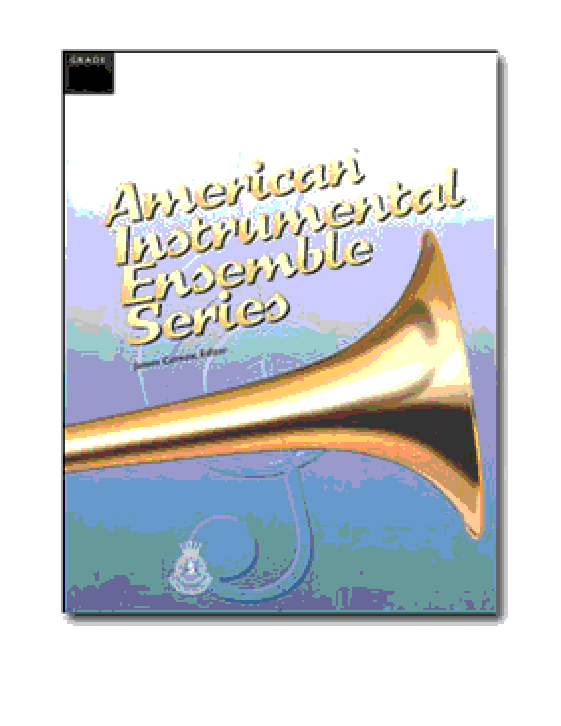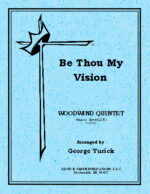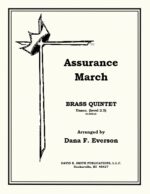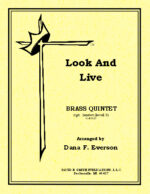| Instrument | |
|---|---|
| Level | 3 |
| Occasion | |
| Theme | Jesus Christ Is Risen Today |
| Writer | |
| Publisher | |
| Copyright | 2002 |
| Key | Db, Bb, F |
| Meter | 4-4 |
| Idiom | Brass quintet (with Eb/F solo feature) |
| Form | Song (ternary) |
Jesus Christ Is Risen Today (Solo Eb/F)
$24.95
Related products
-
-
Meeting In The Air
$12.00A traditional brass quintet with opt. trumpet for horn and extra baritone for use as a sextet. The piece takes off immediately with a thematic statement in the trombone, breaking in a duet with the horn. Additional entries keep massing in the lower voices until most of the ensemble is involved. All of a sudden, the upper brass, silently present the tune in block harmonies until the lower brass present a countermelody. Now! Everybody’s involved. Next, a dialog between the upper brass and middle brass takes place as it alternates back and forth. With a modulation in place the tempo goes slow, the tune is in the lower brass- expressive! All of a sudden from bottom to top motives are presented- in stacked chords…. This goes through different transformations until the piece elevates into an uplifting conclusion.
-
Like A River Glorious
$12.00This quintet (opt. Sextet) begins with extraneous motifs leading into the first statement of the theme in the low brass offset by answering material in the trumpets. The pieces continues in this question and answer texture passing motivic material around the parts. Then in a transition mimicking the beginning a modulation takes place where the theme is more expressive and becomes more aggressive leading up to a majestic coda where it ends on a thought-provoking conclusion.
-
Assurance March
$9.00A traditional brass quintet with opt. trumpet for horn and extra baritone for use as a sextet. A piece in Alle Breve, is simply stated in block chords with an active bass line. The first strain, is repeated, and follows traditional march scoring. The second section is a bit slower and again in block chord structure, but this time with a first trumpet obbligato. With a regaining of tempo and style the piece becomes stronger until a grandiose ending.
-
-
Brighten The Corner Where You Are
$12.00A standard brass quintet with optional trumpet for horn. As one might expect the piece is cheerful from beginning to end. After a bright intro, the trumpet carry the tune until handed over to the middle voices with flourishes in the trumpets. After a transition that leads upward to an exciting climax. The piece abruptly shits to a quiet and expressive section lead by the trombone on the theme where it all builds to another zenith and once again abruptly goes quiet. A modulation and meter shift and the piece becomes countrapuntally gentle.. A meter shift back to the beginning and an exuberant building to a joyous conclusion.
-
Hallelujah! We Shall Rise
$12.00A standard brass quintet with optional baritone for a sextet. The introduction starts in the tuba and then adds more voices as you would expect- rising! The tune is now bantered about between the upper voices and then lower ones. Modulation! And the Q&A game continues. Another modulation and the tempo suddenly changes to a slower, expressive one with the French horn featured. As before the Q&A continues. Another modulation and an “a tempo” where the piece now in full ensemble starts lower and softer and continually adds activity and pitch raising until a vigorous conclusion.
-
Look And Live
$12.00A traditional brass quintet with opt. trumpet for horn and extra baritone for use as a sextet. The introduction uses extraneous material where it leads in the first theme in the French horn, supplemented by trombone counterlines and trumpet flourishes. Thematic movies are then embellished leading up to a modulation where the tempo slows and a new mood encountered. The first trumpet carries the lead and offset with a horn duet line. Another modulation, an a-tempo with the theme in the low brass and accompaniment lines in the middle brass. This continues until the voices stack up until a boisterous conclusion is achieved.









